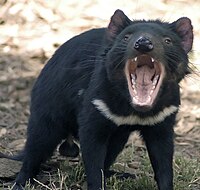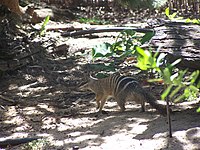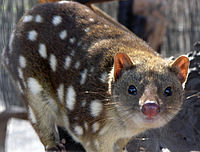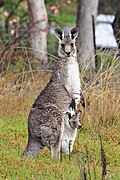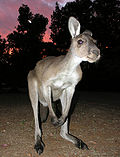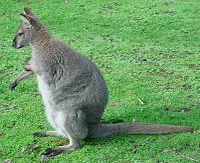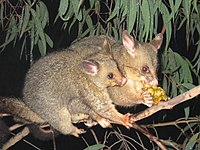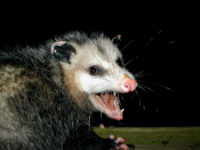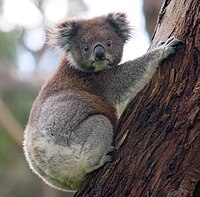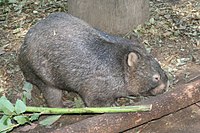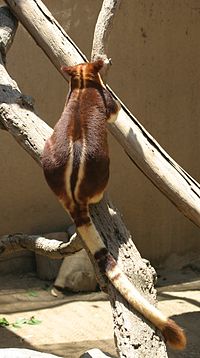|
|
| Line 1: |
Line 1: |
| − | {{otheruses}} | + | {{honor_header|Unknown|Unknown|Nature|South Pacific Division}} |
| − | {{Taxobox
| + | ==1. Distinguish:== |
| − | | name = Tasmanian Devil<ref name=MSW3>{{MSW3 Groves|pages=28}}</ref> | + | ===a. Mammal from other animals.=== |
| − | | status = EN
| + | The mammals are the class of vertebrate animals characterized by the presence of mammary glands, which in females produce milk for the nourishment of young. |
| − | | status_system = EPBC
| |
| − | | status_ref = <ref name="EPBC">Department of Environment and Heritage. [http://www.deh.gov.au/cgi-bin/sprat/public/publicthreatenedlist.pl?wanted=fauna#frogs%20that%20are%20Extinct EPBC Act List of Threatened Fauna]</ref>
| |
| − | | image = Tasdevil_large.jpg
| |
| − | | image_caption = A male Tasmanian Devil.
| |
| − | | regnum = [[Animal]]ia
| |
| − | | phylum = [[Chordate|Chordata]]
| |
| − | | classis = [[Mammal]]ia
| |
| − | | infraclassis = [[Marsupialia]]
| |
| − | | ordo = [[Dasyuromorphia]]
| |
| − | | familia = [[Dasyuridae]]
| |
| − | | genus = ''[[Sarcophilus]]''
| |
| − | | species = '''''S. harrisii'''''
| |
| − | | binomial = ''Sarcophilus harrisii''
| |
| − | | binomial_authority = ([[Pierre Boitard|Boitard]], 1841)
| |
| − | }}
| |
| − | The '''Tasmanian Devil''' (''Sarcophilus harrisii''), also referred to simply as "the devil", is a [[carnivore|carnivorous]] [[marsupial]] now found in the wild only in the [[Australia]]n island [[states and territories of Australia|state]] of [[Tasmania]]. The Tasmanian Devil is the only extant member of the [[genus]] ''[[Sarcophilus]]''. The size of a small [[dog]], but stocky and muscular, the Tasmanian Devil is now the largest carnivorous marsupial in the world after the [[extinction]] of the [[Thylacine]] in 1936. It is characterised by its black fur, offensive odor when stressed, extremely loud and disturbing screech, and viciousness when feeding. It is known to both hunt prey and scavenge [[carrion]] and although it is usually solitary, it sometimes eats with other devils. | |
| | | | |
| − | The Tasmanian Devil became [[Extirpation|extirpated]] on the Australian mainland about 400 years before [[History of Australia before 1901#Colonisation|European settlement]] in 1788. Because they were seen as a threat to [[livestock]] in Tasmania, devils were hunted until 1941, when they became officially protected. Since the late 1990s [[devil facial tumour disease]] has reduced the devil population significantly and now threatens the survival of the species, which in May of 2008 was finally declared to be [[endangered species|endangered]]. Programs are currently being undertaken by the [[Government of Tasmania|Tasmanian government]] to reduce the impact of the disease.
| + | ===b. Placentals, marsupials and monotremes from one another.=== |
| | + | ;Placentals: The placentals are distinguished from other mammals in that the fetus is nourished during pregnancy via a placenta. |
| | | | |
| − | ==Taxonomy==
| + | ;Marsupials:Marsupials are mammals in which the female typically has a pouch (called the marsupium) in which it rears its young through early infancy. They differ from placental mammals in their reproductive traits. |
| | | | |
| − | Naturalist [[George Prideaux Robert Harris|George Harris]] wrote the first published description of the Tasmanian Devil in 1807, naming it ''Didelphis ursina''.<ref name=Harris>Harris, G. P. 1807. Description of two species of Didelphis for Van Diemen's Land. ''Transactions of the Linnean Society of London'', Volume IX</ref> In 1838 the devil was renamed ''Dasyurus laniarius'' by [[Richard Owen]], before being moved to the genus ''Sarcophilus'' in 1841 and named ''Sarcophilus harrisii'', or "Harris's meat-lover", by [[Pierre Boitard]]. A later revision of the devil's taxonomy, published in 1987, attempted to change the species name to ''Sarcophilus laniarius'' based on mainland fossil records of only a few animals.<ref name=Werdelin1987>Werdelin, L. 1987. Some observations on Sarcophilus laniarius and the evolution of Sarcophilus. ''Records of the Queen Victoria Museum, Launceston'', 90:1–27</ref> However, this was not accepted by the taxonomic community at large and the name ''S. harrisii'' has been retained and ''S. laniarius'' relegated to fossil species.<ref name=MSW3/> [[Phylogenetics|Phylogenetic]] analysis shows that the devil is most closely related to [[quoll]]s, and more distantly to the extinct [[Thylacine]] (Tasmanian Tiger).<ref name=Krajewski1992>Krajewski, C. et al. 1992. Phylogenetic relationships of the thylacine (Mammalia:Thylacinidae) among dasyuroid marsupials: evidence from cytochrome ''b'' DNA sequences. ''Proceedings of the Royal Society B-Biological Sciences'' 250:19–27 PMID 1361058</ref>
| + | ;Monotremes: Monotremes are mammals that lay eggs instead of giving birth to live young like marsupials and placental mammals. |
| | | | |
| − | ==Physical description== | + | ==2. Understand how marsupials are classified into families and describe, in a general way, the habits of these families.== |
| − | [[Image:TasmanianDevil 1888.jpg|left|250px|thumb|The Devil's whiskers help it locate prey.]]
| + | Marsupials are classed mainly by their dietary habits. |
| − | The Tasmanian Devil is the largest surviving carnivorous [[marsupial]] in [[Australia]]. It has a squat and thick build, with a large head and a tail which is about half its body length. The devil stores body fat in its tail, so unhealthy devils often have thin tails. Unusual for a marsupial, its forelegs are slightly longer than its hind legs. Devils can run up to {{convert|13|km|abbr=on}} per hour for short distances. The fur is usually black, although irregular white patches on the chest and rump are common. Males are usually larger than females, having an average head and body length of {{convert|652|mm|abbr=on}}, with a {{convert|258|mm|abbr=on}} tail, and an average [[body weight|weight]] of {{convert|8|kg|abbr=on}}. Females have an average head and body length of {{convert|570|mm|abbr=on}}, with a {{convert|244|mm|abbr=on}} tail, and an average weight of {{convert|6|kg|abbr=on}}.<ref name=Guiler1983>Guiler, E.R. 1983. Tasmanian Devil in R. Strahan Ed. ''The Australian Museum Complete Book of Australian Mammals''. p 27–28. Angus & Robertson ISBN 0-207-14454-0 </ref> The average [[life expectancy]] of a Tasmanian Devil in the wild is estimated at six years, although they may live longer in captivity.
| + | ;Herbivorous marsupials: (such as kangaroos, wallabies, koalas, wombats, and possums) eat only plants. |
| | + | ;Carnivorous marsupials: (such as tasmanian devils, numbats, and quolls) eat only meat. They are very similar to one another in shape, though their sizes vary considerably. |
| | + | ;Omnivorous Marsupials: (such as opposums) eat just about anything they can find. |
| | | | |
| − | The devil has long [[Vibrissae|whiskers]] on its face and in clumps on the top of the head. These help the devil locate prey when foraging in the dark, and aid in detecting when other devils are close during feeding. When agitated, the devil can produce a strong odour, its pungency rivaling even the [[skunk]]. Hearing is its dominant sense, and it also has an excellent sense of smell. Since devils hunt at night, their vision seems to be strongest in [[monochromacy|black and white]]. In these conditions they can detect moving objects readily, but have difficulty seeing stationary objects.<ref name=DPIWEweb1>Department of Primary Industries, Water and Environment. [http://www.dpiwe.tas.gov.au/inter.nsf/WebPages/BHAN-5372WP?open Tasmanian Devil - Frequently Asked Questions]</ref> An analysis of mammalian bite force relative to the body size shows that the devil has the strongest bite of any living [[mammal]].<ref name=Wroe2005>Wroe, S, McHenry, C, and Thomason, J. 2005. Bite club: comparative bite force in big biting mammals and the prediction of predatory behaviour in fossil taxa. ''Proceedings of the Royal Society B-Biological Sciences'' 272:619–625 PMID 15817436</ref> The power of the [[jaw]] is in part due to its comparatively large head. A Tasmanian Devil also has one set of teeth that grows slowly throughout its life.<ref name=DPIWEweb1/>
| + | ==3. Describe the distribution, habitat (ie. type of country they live in), diet breeding behavior, as well as any other interesting information of twelve different groups of marsupials and monotremes.== |
| | | | |
| − | ==Reproduction== | + | ===Tasmanian Devil=== |
| − | [[Image:Tasmanina Devil development.PNG|right|thumb|480px|Developmental steps in the maturation of Tasmanian Devil young. The diagonal lines indicate the amount of time the changes take; for example, it takes 41 days for a devil to develop fur over all its body.]] | + | [[Image:Tasdevil large.jpg|thumb|200px]] |
| − | Females start to breed when they reach sexual maturity, typically in their second year. At this point, they become [[Estrus cycle|fertile]] once a year, producing multiple [[ovum|ova]] while in heat.<ref name=Guiler1970>Guiler, E.R. 1970. Observations on the Tasmanian Devil, ''Sarcophilus harrisii'' II. Reproduction, Breeding and Growth of Pouch Young. ''Australian Journal of Zoology'' 18:63–70</ref> Mating occurs in March, in sheltered locations during both day and night. Males fight over females in the breeding season, and female devils will mate with the dominant male. Devils are not [[Monogamy|monogamous]], and females will mate with several males if not guarded after mating. [[Gestation]] lasts 21 days, and devils give birth to up to 50 young,<ref name=DPIWEweb1/> each weighing approximately 0.18–0.24 grams.<ref name=Fischer2001>Fisher, D.O. et al. 2001. The ecological basis of life history variation in marsupials, [http://esapubs.org/archive/ecol/E082/042/appendix-A.htm Appendix A]. ''Ecology'' 82:3531–3540</ref> When the young are born, they move from the vagina to the pouch. Once inside the pouch, they each remain attached to a nipple for the next 100 days. The female Tasmanian Devil's pouch, like that of the [[wombat]], opens to the rear, so it is physically difficult for the female to interact with young inside the pouch. Despite the large litter at birth, the female has only four nipples, so that no more than four young can survive birth. On average, more females survive than males.<ref name=Guiler1970/>
| + | {{clear}} |
| | + | ===Numbat=== |
| | + | [[Image:Numbat_gnangarra_01.jpg|thumb|200px]] |
| | + | {{clear}} |
| | + | ===Dunnart=== |
| | + | ===Quoll=== |
| | + | [[Image:SpottedQuoll 2005 SeanMcClean.jpg|thumb|200px]] |
| | + | {{clear}} |
| | + | ===Kangaroos=== |
| | + | <gallery perrow=3 heights=200px> |
| | + | Image:Red kangaroo - melbourne zoo.jpg|<center>Red Kangaroo</center> |
| | + | Image:Kangaroo and joey03.jpg|<center>Eastern Grey Kanagroo</center> |
| | + | Image:Western Grey Kangaroo SMC 2006.JPG|<center>Western Grey Kangaroo</center> |
| | + | </gallery> |
| | | | |
| − | Inside the pouch, the nourished young develop quickly. At 15 days the [[pinna (anatomy)|external]] parts of the ear are visible. Eyelids are apparent at 16 days, whiskers at 17 days, and the lips at 20 days. The young start to grow fur at 49 days and have a full coat by 90 days. Their eyes open shortly after their fur coat develops—between 87 and 93 days—and their mouths can relax their hold of the nipple at 100 days.<ref name=Guiler1970/> They leave the pouch 105 days after birth, appearing as small copies of the parent and weighing approximately {{convert|500|g}}. Unlike [[kangaroo]] [[Joey (marsupial)|joeys]], young devils do not return to the pouch; instead, they remain in the den for another three months, first venturing outside the den between October and December before becoming independent in January. Female devils are occupied with raising their young for all but approximately six weeks of the year.
| + | There are three species of kangaroo: |
| | + | * The '''Red Kangaroo''' (Macropus rufus) is the largest surviving marsupial anywhere in the world. Fewer in numbers, the Red Kangaroos occupy the arid and semi-arid centre of the continent. A large male can be 2 metres (6 ft 7 in) tall and weigh 90 kg (200 lb). |
| | + | * The '''Eastern Grey Kangaroo''' (Macropus giganteus) is less well-known than the red (outside of Australia), but the most often seen, as its range covers the fertile eastern part of the continent. |
| | + | * The '''Western Grey Kangaroo''' (Macropus fuliginosus) is slightly smaller again at about 54 kg (119 lb) for a large male. It is found in the southern part of Western Australia, South Australia near the coast, and the Darling River basin. |
| | | | |
| − | ==Ecology and behaviour== | + | ===Wallabies=== |
| − | [[Image:Tasmanian Devil resting.jpg|thumb|right|240px|Although Tasmanian Devils are nocturnal, they like to rest in the sun. [[Scar]]ring from fighting is visible next to this devil's left eye.]]Tasmanian Devils are widespread and fairly common throughout Tasmania. Found in all habitats on the island, including the outskirts of urban areas, they particularly like dry [[sclerophyll]] forests and coastal woodlands. The Tasmanian Devil is a [[Nocturnal animal|nocturnal]] and [[crepuscular]] hunter, spending the days in dense bush or in a hole. Young devils can climb trees, but this becomes more difficult as they grow larger. Devils can also swim. They are predominantly solitary animals and do not form packs.<ref name=Fischer2001/> They occupy territories of 8–20 km², which can overlap considerably amongst different animals. | + | [[Image:Red-necked-Wallaby.jpg|thumb|200px]] |
| | + | Essentially, a wallaby is any macropod that isn't large enough to be considered a kangaroo and has not been given some other name. There is no fixed dividing line. In general, a wallaby is smaller and has a stockier build than a kangaroo; a wallaroo is any of a few species somewhat intermediate in size between a wallaby and a kangaroo. |
| | + | {{clear}} |
| | + | ===Possums=== |
| | + | [[Image:Brushtail possum.jpg|thumb|200px]] |
| | + | Possums are small marsupials with brown or grey fur, ranging in size from the length of a finger (pygmy possums and wrist-winged gliders), to the length of a forearm (brushtails and ringtails). All possums are nocturnal and omnivorous, hiding in a nest in a hollow tree during the day and coming out during the night to forage for food. They fill much the same role in the Australian ecosystem that squirrels fill in the northern hemisphere and are broadly similar in appearance. |
| | | | |
| − | [[Image:Devil-eating-roadkill.jpg|thumb|left|A devil eating a [[wallaby]] killed by a car earlier that day]]Tasmanian Devils can take prey up to the size of a small [[wallaby]], but in practice they are opportunistic, and eat [[carrion]] more often than they hunt live prey. Although the devil favours [[wombats]], it will eat all small native mammals, domestic mammals (including sheep), birds, fish, insects, frogs and reptiles. Their diet is largely varied and depends on the food available.<ref name=DPIWEweb1/> On average, they eat about 15% of their body weight each day; however, they can eat up to 40% of their body weight in 30 minutes if the opportunity arises.<ref name=Pemberton1993>Pemberton, D. and Renouf, D. 1993. A field-study of communication and social behaviour of Tasmanian Devils at feeding sites. ''Australian Journal of Zoology'', 41:507–526</ref> Tasmanian Devils eliminate all traces of a carcass, devouring the bones and fur in addition to the meat and internal organs. In this respect, the devil has earned the gratitude of Tasmanian farmers, as the speed at which they clean a carcass helps prevent the spread of insects that might otherwise harm livestock.
| + | The two most common species of possums, the Common Brushtail and Common Ringtail, are also among the largest. |
| | + | {{clear}} |
| | | | |
| − | Eating is a social event for the Tasmanian Devil. Much of the noise attributed to the animal is a result of raucous communal eating, at which up to 12 individuals can gather, and can often be heard several kilometers away. A study of feeding devils identified 20 physical postures, including their characteristic vicious yawn, and the 11 different vocal sounds that devils use to communicate as they feed. They usually establish dominance by sound and physical posturing, although fighting does occur.<ref name=Pemberton1993/> Adult males are the most aggressive, and scarring is common from fighting over food and mates.
| + | ===Opossums=== |
| | + | [[Image:AwesomePossum-AmericanOpossum.jpg|thumb|200px]] |
| | + | Opossums are nocturnal marsupials found in the Western Hemisphere. They are small to medium-sized creatures, about the size of a large house cat. Although there are many exceptions, most of them spend time living both in trees and on the ground, and they eat many different things (plants and animals). |
| | | | |
| − | ==Conservation status==
| + | Opossums are usually nomadic, staying in one area as long as food and water are easily available. Though they will temporarily occupy abandoned burrows, they do not dig or put much effort into building their own. They favor dark, secure areas, below ground or above. |
| − | For some time, Tasmania was the last refuge of large marsupial carnivores. All of the larger carnivorous marsupials became extinct in mainland [[Australia]] shortly after humans arrived. Only the smallest and most adaptable survived. Fossil evidence from western [[Victoria (Australia)|Victoria]] shows that Tasmanian Devils retained a place on the Australian mainland until around 600 years ago (about 400 years before [[History of Australia before 1901#Colonisation|European colonisation]]).<ref name=Guiler1983/> Their extinction is attributed to predation by [[dingo]]es and hunting by [[indigenous Australian]]s.<ref name=Johnson2003>Johnson, C.N. and Wroe, S. 2003. Causes of extinction of vertebrates during the Holocene of mainland Australia: arrival of the dingo, or human impact? ''Holocene'' 13:941–948</ref> In dingo-free Tasmania, carnivorous marsupials were still active when Europeans arrived. The extermination of the [[Thylacine]] after the arrival of the Europeans is well known, but the Tasmanian Devil was threatened as well.
| |
| | | | |
| − | The first Tasmanian settlers ate Tasmanian Devil, which they described as tasting like veal.<ref name=Harris/> As it was believed devils would hunt and kill livestock, a bounty scheme to remove the devil from rural properties was introduced as early as 1830. Over the next 100 years, trapping and poisoning brought them to the brink of extinction. After the death of the last Thylacine in 1936, the threat to the devils was recognized. The Tasmanian Devil was protected by law in 1941, and the population slowly recovered.
| + | When threatened or harmed, they will "play possum", mimicking the appearance and smell of a sick or dead animal. The lips are drawn back, teeth are bared, saliva foams around the mouth, and a foul-smelling fluid is secreted from glands. This response is involuntary, rather than a conscious act. Their stiff, curled form can be prodded, turned over, and even carried away. Many injured opossums have been killed by well-meaning people who find a catatonic animal and assume the worst. If you find an injured or apparently dead opossum, the best thing to do is leave it in a quiet place with a clear exit path. In minutes or hours, the animal will regain consciousness and escape quietly on its own. |
| | + | {{clear}} |
| | + | ===Shrew Opossums=== |
| | + | [[Image:Shrew opossum - Caenolestidae.png|thumb|200px]] |
| | + | Shrew opossums (also known as rat opossums) are about the size of a small rat (9–14 cm long), with thin limbs, a long, pointed snout and a slender, hairy tail. They are largely meat-eaters, being active hunters of insects, earthworms and small vertebrates. They have small eyes and poor sight, and hunt in the early evening and at night, using their hearing and long, sensitive whiskers to locate prey. They seem to spend much of their lives in underground burrows and on surface runways. |
| | | | |
| − | At least two major population declines, possibly due to a disease epidemic, have occurred in recorded history: in 1909 and 1950.<ref name=Guiler1983/> The Tasmanian Devil's current population is reported by Tasmania's Department of Primary Industries and Water as being in the range of 10,000 to 100,000 individuals, with 20,000 to 50,000 mature individuals being likely.<ref name=DPIWEweb1/> Senior Scientist for the Devil Facial Tumour Disease program Hamish McCallum offers a more conservative estimate of at least 20,000 individuals and at most 75,000.<ref name=Byrnes>Byrnes, M. 2007. [http://www.alertnet.org/thenews/newsdesk/SYD321428.htm Battle to save Tasmanian devil from extinction] Retrieved on 15 March 2007.</ref>
| + | Largely because of their rugged, inaccessible habitat, they are very poorly known and have traditionally been considered rare. Recent studies suggest that they may be more common than had been thought. |
| | + | {{clear}} |
| | + | ===Koalas=== |
| | + | [[Image:Koala climbing tree.jpg|thumb|200px]] |
| | + | The Koala is broadly similar in appearance to the wombat, but has a thicker, more luxurious coat, much larger ears, and longer limbs, which are equipped with large, sharp claws to assist with climbing. Weight varies from about 14 kg for a large, southern male, to about 5 kg for a small northern female. Contrary to popular belief, their fur is thick, not soft and cuddly. Koalas' five fingers per paw are arranged with the first two as opposable thumbs, providing better gripping ability. |
| | + | {{clear}} |
| | + | ===Wombats=== |
| | + | [[Image:Wombat at Lone Pine.jpg|thumb|200px]] |
| | + | Wombats are Australian marsupials; they are short-legged, muscular quadrupeds, approximately one meter (3 feet) in length and with a very short tail. Wombats have an extraordinarily slow metabolism, taking around 14 days to complete digestion, and generally move slowly. When required, however, they can reach up to 40 km/h and maintain that speed for up to 90 seconds. |
| | | | |
| − | ===Devil facial tumour disease=== | + | When attacked, they can summon immense reserves of strength — one defense of a wombat against a predator (such as a Dingo) underground is to crush it against the roof of the tunnel until it stops breathing. |
| − | [[Image:Tasmanian Devil Facial Tumour Disease.png|right|thumb|200px|Devil facial tumour disease causes tumours to form in and around the mouth, interfering with feeding and eventually leading to death by starvation.]] | + | {{clear}} |
| − | {{main|Devil facial tumour disease}}
| + | ===Tree-kangaroo=== |
| − | First seen in 1995, [[devil facial tumour disease]] (DFTD) has ravaged Tasmania's wild devils, and estimates of the impact range from 20% to as much as a 50% decline in the devil population with over 65% of the State affected.<ref name=DFTDUpdateJune20005>DPIWE. 2005. [http://www.dpiwe.tas.gov.au/inter.nsf/Attachments/LBUN-6D73V5/$FILE/Tas_devil_update_June2005.pdf Devil Facial Tumour Disease - Update June 2005]</ref><ref name=DPIWEDMS2005>DPIWE. 2005. [http://www.dpiwe.tas.gov.au/inter.nsf/Attachments/LBUN-6996MH/$FILE/DFTD_DMS_Feb05a.pdf Tasmanian Devil Facial Tumor Disease, Disease Management Strategy]</ref> Affected high-density populations suffer up to 100% mortality in 12–18 months.<ref name=DPIWEweb3>DPIWE. [http://www.dpiwe.tas.gov.au/inter.nsf/WebPages/LBUN-5QF86G?open Disease Affecting Tasmanian Devils]</ref> The species was listed as vulnerable under the Tasmanian ''Threatened Species Protection Act 1995'' and the Australian ''[[Environment Protection and Biodiversity Conservation Act 1999]]'' in 2006 which means that it is at risk of extinction in the "medium term".<ref name="2006 listing">DPIWE. 2006. [http://www.dpiw.tas.gov.au/inter.nsf/Attachments/LBUN-6MW7Y8/$FILE/devilNews_March2006.pdf Devil Facial Tumor Disease, Newsletter March]</ref><ref>Department of the Environment and Heritage. July 2006. [http://www.deh.gov.au/epbc/publications/pubs/tasmanian-devil-policy.pdf EPBC Policy Statement 3.6 - Tasmanian Devil (Sarcophilus harrisii)]</ref> The [[IUCN]] does not regard the species as threatened; when this species was last evaluated for the IUCN in 1996, it was listed as lower risk/least concern.<ref name=IUCN>{{IUCN2006 | assessors = Australasian Marsupial & Monotreme Specialist Group | year = 1996 | title = Sarcophilus harrisii | id = 40540 | downloaded = [[2007-07-21]]}}</ref>
| + | [[Image:Buergers' Tree-kangaroo back and tail.jpg|thumb|200px]] |
| | + | Tree-kangaroos are macropods adapted for life in trees. They are found in the rainforests of New Guinea, far northeastern Queensland, and nearby islands, usually in mountainous areas. Although most are found in mountainous areas, several species also occur in lowlands, and one, the aptly named Lowlands Tree-kangaroo, appears to be restricted to lowlands. |
| | | | |
| − | Wild Tasmanian Devil populations are being monitored to track the spread of the disease and to identify changes in disease prevalence. Field monitoring involves trapping devils within a defined area to check for the presence of the disease and determine the number of affected animals. The same area is visited repeatedly to characterise the spread of the disease over time. So far, it has been established that the short-term effects of the disease in an area can be severe. Long-term monitoring at replicated sites will be essential to assess whether these effects remain, or whether populations can recover.<ref name=DPIWEDMS2005/> Field workers are also testing the effectiveness of disease suppression by trapping and removing diseased devils. It is hoped that the removal of diseased devils from wild populations should decrease disease prevalence and allow more devils to survive beyond their juvenile years and breed.<ref name=DPIWEDMS2005/>
| + | Tree-kangaroos feed mostly on leaves and fruit, taken both in trees and on the ground, but other foods are eaten when available, including grain, flowers, sap, bark, eggs and young birds. Their teeth are adapted for tearing leaves rather than cutting grass. |
| | + | {{clear}} |
| | | | |
| − | Two "insurance" populations of disease-free devils are being established at an urban facility in the [[Hobart]] suburb of [[Taroona]] and on [[Maria Island]] off the east coast of Tasmania. [[Captive breeding]] in mainland zoos is also a possibility. The decline in devil numbers is also seen as an ecological problem, since its presence in the Tasmanian forest [[ecosystem]] is believed to have prevented the establishment of the [[Red Fox]], illegally introduced to Tasmania in 2001.<ref name=DPIWEweb3/><ref name=Bostanci2005>Bostanci, A. 2005. A Devil of a Disease. ''[[Science (journal)|Science]]'', 307:1035 PMID 15718445</ref> Foxes are a problematic [[invasive species]] in all other [[States and territories of Australia|Australian States]], and the establishment of foxes in Tasmania would hinder the recovery of the Tasmanian Devil.
| + | ===Wallaroo=== |
| | + | ===Pademelon=== |
| | + | ===Quokka=== |
| | | | |
| − | Recent research from the [[University of Sydney]] has shown that the infectious facial cancer may be able to spread because of vanishingly low [[genetic diversity]] in devil immune genes ([[MHC class I]] and [[MHC class II|II]]) — raising questions about how well small, and potentially inbred, populations of animals are able to survive.<ref>{{cite news |title=Tasmanian devil epidemic: cause isolated? |url=http://www.cosmosmagazine.com/node/1412 |work=Cosmos Magazine |date=[[27 June]][[2007]]}}</ref>
| + | ==4. Be able to explain the difference between marsupial reproduction and that in true mammals (ie. placentals).== |
| | + | The pregnant female marsupial develops a kind of yolk sack in her womb which delivers nutrients to the embryo. The embryo is born at a very early stage of development (at about 4-5 weeks), upon which it crawls up its mother's belly and attaches itself to a nipple (which is located inside the pouch). It remains attached to the nipple for a number of weeks. The offspring later passes through a stage where it temporarily leaves the pouch, returning for warmth and nourishment. |
| | | | |
| − | ==Cultural references==
| + | The placenta is a temporary organ composed of two parts, one of which is part of the fetus, the other part of the mother. It is implanted in the wall of the uterus, where it receives nutrients and oxygen from the mother's blood and passes out waste. This interface forms a barrier, the placental barrier, which filters out some substances which could harm the fetus. |
| − | [[Image:Young tasmanian devil.jpg|right|thumb|The devil's ears turn bright red when aroused.]]
| |
| − | The Tasmanian Devil is an iconic animal within Australia; it is the symbol of the Tasmanian National Parks and Wildlife Service, and the Tasmanian [[Australian rules football]] team which plays in the [[Victorian Football League]] is known as the [[Tasmanian Devils Football Club|Devils]]. The defunct [[Hobart Devils]] [[basketball]] team in the [[National Basketball League (Australia)|NBL]] was also named after the animal. The devil was one of six native Australian animals to appear on commemorative [[Australian coins#Collectable coins|Australian two hundred dollar coins]] issued between 1989 and 1994. Tasmanian Devils are popular with domestic and international tourists. Because of their unique personality the Tasmanian Devil has been the subject of numerous <!-- Acceptable link to disambiguation page -->[[Documentary film|documentaries]] and non-fiction children's books. The most recent Australian documentary on the Tasmanian Devil, ''Terrors of Tasmania'', directed and produced by [[David Parer]] and [[Elizabeth Parer-Cook]], was released in 2005. The documentary follows a female devil called ''Manganinnie'' through breeding season and the birth and rearing of her young. The documentary also looks at the effect of devil facial tumor disease and the conservation measures being taken to ensure survival of the Tasmanian Devil. The documentary has screened on television in Australia and in the [[United States]] on the [[National Geographic Channel]]. | |
| | | | |
| − | Restrictions on the export of the Tasmanian Devil means that devils can only be seen kept in captivity in Australia. The last known overseas devil died at the [[Fort Wayne Children's Zoo]] in 2004.<ref name=zoo>[http://www.highbeam.com/doc/1P1-94713891.html LAST TASMANIAN DEVIL NOT IN AUSTRALIA DIES - United Press International - HighBeam Research<!-- Bot generated title -->]</ref> However, the Tasmanian Government has sent a pair of devils to the [[Copenhagen Zoo]], following the birth of the [[Prince Christian of Denmark|first son]] of [[Frederik, Crown Prince of Denmark]] and his Tasmanian wife [[Mary, Crown Princess of Denmark|Mary]] in October 2005.<ref name=Devilgift>''Tassie sends devils to celebrate birth'', AAP, October 17, 2005</ref> These are the only devils that can be seen outside Australia.
| + | ==5. Explain the significance of the direction of opening of the pouch and the number of young per litter in marsupials.== |
| | + | [[Image:Joey in pouch.jpg|thumb|200px|Kangaroo joey inside the pouch]] |
| | + | The pouch is a distinguishing feature of female marsupials; the name marsupial is derived from the Latin marsupium, meaning pouch. Marsupials give birth to a live but relatively undeveloped fetus called a joey. When the joey is born it crawls from inside the mother to the pouch. The pouch is basically a fold of skin with a single opening that covers the nipples to protect the joey as it continues to develop. |
| | | | |
| − | The Tasmanian Devil is probably best known internationally as the inspiration for the ''[[Looney Tunes]]'' cartoon character [[Tasmanian Devil (Looney Tunes)|The Tasmanian Devil]], or "Taz". While the cartoon incarnation does resemble a stylized Devil (prominent canines, large head, short legs) the behavioral similarities between the two seem to be limited, consisting mainly of a noisy comportment, voracious appetite, and shy demeanor. Researchers have also named a genetic-mutant [[mouse]] "the Tasmanian devil". The mutant mouse is defective in the development of sensory-hair cells of the ear, leading the mutant to abnormal behaviours including head-tossing and circling,<ref name=Erven2002>Erven, A. et al. 2002. A novel stereocilia defect in sensory hair cells of the deaf mouse mutant Tasmanian Devil. ''European Journal of Neuroscience'' 16:1433–1441 PMID 12405956</ref> more like the cartoon "Taz" than the actual Tasmanian Devil.
| + | Pouches are different amongst the different marsupials: for example for Quolls and Tasmanian Devils, the pouch opens to the rear and the joey only has to travel a short distance to get to the opening of the pouch. While in the pouch they are permanently attached to the nipple and once the young have developed they leave the pouch and do not return. The kangaroo's pouch opens horizontally on the front of the body, and the joey must climb a relatively long way to reach it. Kangaroos and wallabies allow their young to live in the pouch well after they are physically capable of leaving. |
| | | | |
| − | ==See also==
| + | Tasmanian Devils give birth to up to 50 young, each weighing approximately 0.18–0.24 grams. When the young are born, they move from the vagina to the pouch. Once inside the pouch, they each remain attached to a nipple for the next 100 days. Despite the large litter at birth, the female has only four nipples, so that no more than four young can survive birth. On average, more females survive than males. The female Tasmanian Devil's pouch, like that of the wombat, opens to the rear, so it is physically difficult for the female to interact with young inside the pouch. Unlike kangaroo joeys, young devils (and other marsupials with rear-opening pouches) do not return to the pouch; instead, they remain in the den for another three months, first venturing outside the den between October and December before becoming independent in January. |
| − | {{portalpar|Mammals}}
| |
| − | *[[Fauna of Australia]]
| |
| − | *[[Threatened fauna of Australia]]
| |
| | | | |
| | + | ==6. Give an explanation of the unique occurrence of marsupials in Australia.== |
| | + | ==7. Be able to explain the need for conservation of our marsupials.== |
| | + | ==8. Write a report of your visit to a natural history museum, wild-life sanctuary, zoo, etc. indicating in about 10-15 lines, the extent of your observations.== |
| | + | ==References== |
| | | | |
| − | ==Notes and references==
| + | [[Category:Adventist Youth Honors Answer Book|{{SUBPAGENAME}}]] |
| − | <!--This article uses the Cite.php citation mechanism. If you would like more information on how to add references to this article, please see http://meta.wikimedia.org/wiki/Cite/Cite.php -->
| |
| − | {{reflist}}
| |
| − | | |
| − | ==External links==
| |
| − | {{Commons|Sarcophilus}}
| |
| − | {{Wikispecies|Sarcophilus harrisii}}
| |
| − | {{Spoken Wikipedia|Tasmanian_Devil.ogg|2006-08-08}}
| |
| − | *[http://www.parks.tas.gov.au/wildlife/mammals/devil.html Parks and Wildlife Tasmania - Tasmanian Devil] vocalisation, movie, faq
| |
| − | *[http://www.tassiedevil.com.au/ Save the Tasmanian Devil]
| |
| − | *[http://www.mainlanddevils.com/ Mainland Tasmanian Devils] Do Tasmanian Devils still exist in mainland Australia?
| |
| − | | |
| − | {{Dasyuromorphia|D.D.}}
| |
| − | {{featured article}}
| |
| − | | |
| − | [[Category:Carnivorous marsupials]] | |
| − | [[Category:Dasyuromorphs]]
| |
| − | [[Category:Vulnerable fauna of Australia]]
| |
| − | [[Category:Mammals of Tasmania]]
| |
| − | [[Category:Marsupials of Australia]]
| |
| − | [[Category:Scavengers]]
| |
| − | | |
| − | {{Link FA|de}}
| |
| − | {{Link FA|he}} | |
| − | [[ca:Diable de Tasmània]]
| |
| − | [[cs:Ďábel medvědovitý]]
| |
| − | [[da:Tasmansk djævel]]
| |
| − | [[de:Beutelteufel]]
| |
| − | [[es:Sarcophilus harrisii]]
| |
| − | [[fa:شیطان تاسمانی]]
| |
| − | [[fi:Pussiahma]]
| |
| − | [[fr:Diable de Tasmanie]]
| |
| − | [[he:שד טסמני]]
| |
| − | [[hu:Erszényes ördög]]
| |
| − | [[id:Setan Tasmania]]
| |
| − | [[is:Tasmaníuskolli]]
| |
| − | [[it:Sarcophilus harrisii]]
| |
| − | [[ja:タスマニアデビル]]
| |
| − | [[ko:태즈메이니아 데빌]]
| |
| − | [[la:Sarcophilus harrisii]]
| |
| − | [[lt:Sterblinis velnias]]
| |
| − | [[nl:Tasmaanse duivel]]
| |
| − | [[nn:Tasmansk djevel]]
| |
| − | [[no:Tasmansk djevel]]
| |
| − | [[pl:Diabeł tasmański]]
| |
| − | [[pt:Diabo-da-tasmânia]]
| |
| − | [[ru:Тасманский дьявол]]
| |
| − | [[simple:Tasmanian Devil]]
| |
| − | [[sl:Tasmanski vrag]]
| |
| − | [[sv:Tasmansk djävul]]
| |
| − | [[tr:Tazmanya canavarı]]
| |
| − | [[zh:袋獾]]
| |
Template:Honor header
1. Distinguish:
a. Mammal from other animals.
The mammals are the class of vertebrate animals characterized by the presence of mammary glands, which in females produce milk for the nourishment of young.
b. Placentals, marsupials and monotremes from one another.
- Placentals
- The placentals are distinguished from other mammals in that the fetus is nourished during pregnancy via a placenta.
- Marsupials
- Marsupials are mammals in which the female typically has a pouch (called the marsupium) in which it rears its young through early infancy. They differ from placental mammals in their reproductive traits.
- Monotremes
- Monotremes are mammals that lay eggs instead of giving birth to live young like marsupials and placental mammals.
2. Understand how marsupials are classified into families and describe, in a general way, the habits of these families.
Marsupials are classed mainly by their dietary habits.
- Herbivorous marsupials
- (such as kangaroos, wallabies, koalas, wombats, and possums) eat only plants.
- Carnivorous marsupials
- (such as tasmanian devils, numbats, and quolls) eat only meat. They are very similar to one another in shape, though their sizes vary considerably.
- Omnivorous Marsupials
- (such as opposums) eat just about anything they can find.
3. Describe the distribution, habitat (ie. type of country they live in), diet breeding behavior, as well as any other interesting information of twelve different groups of marsupials and monotremes.
Tasmanian Devil
Numbat
Dunnart
Quoll
Kangaroos
There are three species of kangaroo:
- The Red Kangaroo (Macropus rufus) is the largest surviving marsupial anywhere in the world. Fewer in numbers, the Red Kangaroos occupy the arid and semi-arid centre of the continent. A large male can be 2 metres (6 ft 7 in) tall and weigh 90 kg (200 lb).
- The Eastern Grey Kangaroo (Macropus giganteus) is less well-known than the red (outside of Australia), but the most often seen, as its range covers the fertile eastern part of the continent.
- The Western Grey Kangaroo (Macropus fuliginosus) is slightly smaller again at about 54 kg (119 lb) for a large male. It is found in the southern part of Western Australia, South Australia near the coast, and the Darling River basin.
Wallabies
Essentially, a wallaby is any macropod that isn't large enough to be considered a kangaroo and has not been given some other name. There is no fixed dividing line. In general, a wallaby is smaller and has a stockier build than a kangaroo; a wallaroo is any of a few species somewhat intermediate in size between a wallaby and a kangaroo.
Possums
Possums are small marsupials with brown or grey fur, ranging in size from the length of a finger (pygmy possums and wrist-winged gliders), to the length of a forearm (brushtails and ringtails). All possums are nocturnal and omnivorous, hiding in a nest in a hollow tree during the day and coming out during the night to forage for food. They fill much the same role in the Australian ecosystem that squirrels fill in the northern hemisphere and are broadly similar in appearance.
The two most common species of possums, the Common Brushtail and Common Ringtail, are also among the largest.
Opossums
Opossums are nocturnal marsupials found in the Western Hemisphere. They are small to medium-sized creatures, about the size of a large house cat. Although there are many exceptions, most of them spend time living both in trees and on the ground, and they eat many different things (plants and animals).
Opossums are usually nomadic, staying in one area as long as food and water are easily available. Though they will temporarily occupy abandoned burrows, they do not dig or put much effort into building their own. They favor dark, secure areas, below ground or above.
When threatened or harmed, they will "play possum", mimicking the appearance and smell of a sick or dead animal. The lips are drawn back, teeth are bared, saliva foams around the mouth, and a foul-smelling fluid is secreted from glands. This response is involuntary, rather than a conscious act. Their stiff, curled form can be prodded, turned over, and even carried away. Many injured opossums have been killed by well-meaning people who find a catatonic animal and assume the worst. If you find an injured or apparently dead opossum, the best thing to do is leave it in a quiet place with a clear exit path. In minutes or hours, the animal will regain consciousness and escape quietly on its own.
Shrew Opossums
Shrew opossums (also known as rat opossums) are about the size of a small rat (9–14 cm long), with thin limbs, a long, pointed snout and a slender, hairy tail. They are largely meat-eaters, being active hunters of insects, earthworms and small vertebrates. They have small eyes and poor sight, and hunt in the early evening and at night, using their hearing and long, sensitive whiskers to locate prey. They seem to spend much of their lives in underground burrows and on surface runways.
Largely because of their rugged, inaccessible habitat, they are very poorly known and have traditionally been considered rare. Recent studies suggest that they may be more common than had been thought.
Koalas
The Koala is broadly similar in appearance to the wombat, but has a thicker, more luxurious coat, much larger ears, and longer limbs, which are equipped with large, sharp claws to assist with climbing. Weight varies from about 14 kg for a large, southern male, to about 5 kg for a small northern female. Contrary to popular belief, their fur is thick, not soft and cuddly. Koalas' five fingers per paw are arranged with the first two as opposable thumbs, providing better gripping ability.
Wombats
Wombats are Australian marsupials; they are short-legged, muscular quadrupeds, approximately one meter (3 feet) in length and with a very short tail. Wombats have an extraordinarily slow metabolism, taking around 14 days to complete digestion, and generally move slowly. When required, however, they can reach up to 40 km/h and maintain that speed for up to 90 seconds.
When attacked, they can summon immense reserves of strength — one defense of a wombat against a predator (such as a Dingo) underground is to crush it against the roof of the tunnel until it stops breathing.
Tree-kangaroo
Tree-kangaroos are macropods adapted for life in trees. They are found in the rainforests of New Guinea, far northeastern Queensland, and nearby islands, usually in mountainous areas. Although most are found in mountainous areas, several species also occur in lowlands, and one, the aptly named Lowlands Tree-kangaroo, appears to be restricted to lowlands.
Tree-kangaroos feed mostly on leaves and fruit, taken both in trees and on the ground, but other foods are eaten when available, including grain, flowers, sap, bark, eggs and young birds. Their teeth are adapted for tearing leaves rather than cutting grass.
Wallaroo
Pademelon
Quokka
4. Be able to explain the difference between marsupial reproduction and that in true mammals (ie. placentals).
The pregnant female marsupial develops a kind of yolk sack in her womb which delivers nutrients to the embryo. The embryo is born at a very early stage of development (at about 4-5 weeks), upon which it crawls up its mother's belly and attaches itself to a nipple (which is located inside the pouch). It remains attached to the nipple for a number of weeks. The offspring later passes through a stage where it temporarily leaves the pouch, returning for warmth and nourishment.
The placenta is a temporary organ composed of two parts, one of which is part of the fetus, the other part of the mother. It is implanted in the wall of the uterus, where it receives nutrients and oxygen from the mother's blood and passes out waste. This interface forms a barrier, the placental barrier, which filters out some substances which could harm the fetus.
5. Explain the significance of the direction of opening of the pouch and the number of young per litter in marsupials.
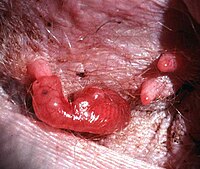
Kangaroo joey inside the pouch
The pouch is a distinguishing feature of female marsupials; the name marsupial is derived from the Latin marsupium, meaning pouch. Marsupials give birth to a live but relatively undeveloped fetus called a joey. When the joey is born it crawls from inside the mother to the pouch. The pouch is basically a fold of skin with a single opening that covers the nipples to protect the joey as it continues to develop.
Pouches are different amongst the different marsupials: for example for Quolls and Tasmanian Devils, the pouch opens to the rear and the joey only has to travel a short distance to get to the opening of the pouch. While in the pouch they are permanently attached to the nipple and once the young have developed they leave the pouch and do not return. The kangaroo's pouch opens horizontally on the front of the body, and the joey must climb a relatively long way to reach it. Kangaroos and wallabies allow their young to live in the pouch well after they are physically capable of leaving.
Tasmanian Devils give birth to up to 50 young, each weighing approximately 0.18–0.24 grams. When the young are born, they move from the vagina to the pouch. Once inside the pouch, they each remain attached to a nipple for the next 100 days. Despite the large litter at birth, the female has only four nipples, so that no more than four young can survive birth. On average, more females survive than males. The female Tasmanian Devil's pouch, like that of the wombat, opens to the rear, so it is physically difficult for the female to interact with young inside the pouch. Unlike kangaroo joeys, young devils (and other marsupials with rear-opening pouches) do not return to the pouch; instead, they remain in the den for another three months, first venturing outside the den between October and December before becoming independent in January.
6. Give an explanation of the unique occurrence of marsupials in Australia.
7. Be able to explain the need for conservation of our marsupials.
8. Write a report of your visit to a natural history museum, wild-life sanctuary, zoo, etc. indicating in about 10-15 lines, the extent of your observations.
References
